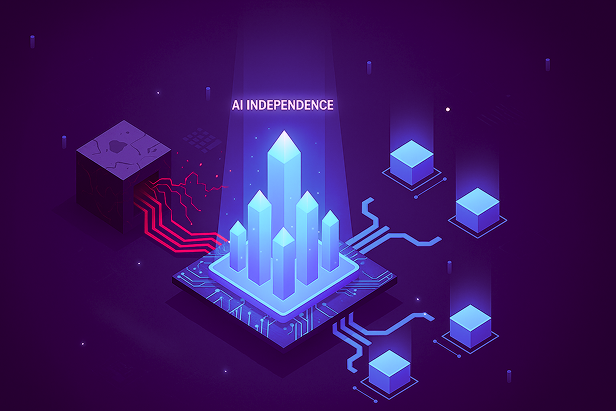From Digital Colony to AI Sovereign: Europe's Blueprint for AI Independence

When Foreign Laws Cross Oceans
September 11, 2001 didn't just change American security policy—it exported American legal authority worldwide. The USA Patriot Act granted FBI and other agencies unprecedented power to demand data from U.S. companies anywhere on Earth, bypassing traditional judicial oversight.
European companies using American cloud services discovered their data could be seized by foreign authorities without their knowledge or consent. For the first time in modern history, one nation's domestic laws became another continent's operational reality.
Edward Snowden's 2013 revelations showed this wasn't theoretical. Millions of European communications had been systematically collected through American technology platforms. The social media revolution had convinced people to digitize their most private thoughts, only to discover they'd surrendered sovereignty over their own information.
Europe responded with GDPR—the world's most comprehensive data protection framework. America countered with the CLOUD Act, explicitly legalizing government access to any data controlled by U.S. companies, regardless of where it's stored.
Two continents, two visions of digital rights.
The Supply Chain Wake-Up Call
COVID-19 exposed another dimension of technological vulnerability. European factories went silent waiting for Taiwanese semiconductors. Citizens queued for Chinese-manufactured masks. Critical medical equipment depended on supply chains spanning multiple continents.
The pandemic revealed an uncomfortable truth: Europe had traded away manufacturing capabilities for efficiency, creating dependencies that became liabilities during crisis.
Then ChatGPT launched.
Within months, millions of Europeans were using AI to write emails, generate code, and make decisions. But every query was processed on American servers, using American-trained models, under American corporate control. The pattern was repeating with the most transformative technology of the century.
The Catastrophic Cost of AI Dependency
AI dependency creates business risks that traditional technology never posed:
Instant Business Elimination
In early 2024, OpenAI launched GPT-4.5 API access. Startups across Europe built entire products around this model—fine-tuning workflows, training employees, securing customer contracts based on specific capabilities.
OpenAI shut it down within months.
Not due to technical failure, but cost considerations. One board meeting in San Francisco eliminated companies across multiple continents. This represents dependency at its most dangerous: external corporate decisions can instantly destroy businesses that took years to build.
Cultural Imperialism Through Code
DeepSeek, China's celebrated AI model, impressed users with cost-efficient training methods. But journalists discovered something alarming: ask about Taiwan or Tiananmen Square, and it provides answers aligned with Chinese state positions.
This bias was obvious. Most cultural programming isn't.
When AI models trained on predominantly American data respond to European users, they embed American cultural assumptions, legal concepts, and social values into everyday interactions. Over time, this shapes how entire populations think about complex issues.
Deconstructing AI: The Sovereignty Stack
AI sovereignty requires understanding five interdependent layers:
Infrastructure Layer: Physical hardware including chips, GPUs, and data centers. Europe remains heavily dependent on Taiwanese semiconductors and American GPU manufacturers, but European cloud providers are expanding rapidly.
Data Layer: Training datasets that teach models and inference data from daily usage. This layer determines whose perspectives and biases become embedded in AI behavior.
Model Layer: The algorithms themselves, including training processes and runtime configurations. Control here determines whether AI behavior can be modified to align with local values and requirements.
Application Layer: Software that makes AI useful for specific business functions. This is where theoretical capabilities become practical business value.
Governance Layer: Security, compliance, and operational oversight that ensures AI systems behave according to organizational requirements rather than external priorities.
Most organizations control only the application layer while depending entirely on foreign entities for everything beneath.
The Assessment Framework
Organizations can evaluate their AI sovereignty using five fundamental questions:
- Who controls the infrastructure? Are the servers, networks, and facilities operated by entities aligned with your interests and subject to your legal system?
- Where does data processing occur? Does information remain within trusted jurisdictions, or does it cross borders into legal systems with different priorities?
- What training influenced the model? Can you verify that the AI's foundational learning aligns with your values and requirements?
- How does the model behave in practice? Can you predict, modify, and control AI responses to ensure they serve your objectives?
- When might access be restricted? What happens if external providers change terms, pricing, or availability based on their priorities rather than yours?
Organizations that cannot confidently answer these questions operate under someone else's technological sovereignty.
The Spectrum of Control
AI sovereignty exists on a continuum with different cost-benefit tradeoffs:
API Dependency (Zero Sovereignty): Using services like GPT-4 or Claude through external APIs. Maximum convenience and performance, zero control over availability, behavior, or data handling.
Weight Access (Limited Control): Deploying models like Llama locally using provided parameters. Some control over hosting and fine-tuning, but fundamental capabilities remain determined by the original training process.
Open Source Implementation (Operational Independence): Using fully open models where code, training methods, and data sources are transparent. Significant control with transparency, but still dependent on others' foundational work.
Custom Development (Complete Sovereignty): Building AI systems from scratch with full control over data, training, and deployment. Maximum alignment with specific requirements, but requires substantial resources and expertise.
Europe's Strategic Response
European institutions are building alternatives across the sovereignty spectrum:
Linguistic Sovereignty: Token-7B, developed by Germany's Fraunhofer Institute, represents the first major language model trained equally on all 24 official European languages. Language shapes thought—AI trained primarily on English inevitably reflects Anglo-American perspectives.
Regulatory Compliance: Apertus, under development by Swiss universities, aims to be the first AI model trained in full compliance with EU AI Act transparency requirements. Every training decision and data source will be documented and auditable.
Infrastructure Independence: European telecommunications companies and cloud providers are expanding sovereign computing capabilities, creating alternatives to American and Chinese infrastructure.
The Business Case for AI Sovereignty
Organizations face several categories of risk when dependent on foreign AI systems:
- Operational Risk: External providers can change terms, pricing, or availability based on their business priorities rather than customer needs.
- Compliance Risk: AI behavior trained under different regulatory frameworks may violate local laws or professional standards.
- Competitive Risk: Competitors using the same external AI services gain no sustainable advantage, while those controlling their AI stack can optimize for specific use cases.
- Strategic Risk: Dependence on external AI creates single points of failure that can eliminate entire business capabilities overnight.
- Cultural Risk: AI trained on foreign data and values may produce outputs that conflict with local customs, legal requirements, or customer expectations.
Choosing Your Sovereignty Level
Not every organization requires complete AI independence. A European law firm handling sensitive client data needs different controls than a restaurant using AI for menu translation.
The key is making deliberate choices rather than defaulting to whatever marketing promises the most convenience:
High-sovereignty organizations (governments, healthcare, finance, defense) typically require local data processing, auditable training processes, and guaranteed availability under local legal control.
Medium-sovereignty organizations (enterprises with sensitive data or regulatory requirements) may benefit from hybrid approaches using open-source models on sovereign infrastructure with some external capabilities for non-sensitive applications.
Low-sovereignty organizations (small businesses, non-sensitive applications) might prioritize functionality and cost over control, while maintaining awareness of potential risks.
The Regulatory Divergence
Recent policy shifts highlight why sovereignty matters:
The EU AI Act establishes comprehensive oversight requirements emphasizing transparency, human oversight, and fundamental rights protection. It treats AI as a technology requiring careful regulation to prevent societal harm.
Recent American policy changes emphasize deregulation and competitive advantage, treating AI development primarily as an economic and strategic race with minimal oversight constraints.
These philosophical differences mean AI developed under one framework may fundamentally conflict with the other's requirements and values.
Beyond Compliance: Strategic Advantage
AI sovereignty isn't just defensive—it creates competitive advantages:
- Customization: Organizations controlling their AI stack can optimize for specific use cases, languages, and cultural contexts rather than accepting generic solutions.
- Innovation Speed: Direct control over AI capabilities enables rapid experimentation and deployment without external approval processes or API limitations.
- Data Leverage: Organizations keeping data processing internal can use proprietary information to improve AI performance without sharing competitive intelligence with external providers.
- Reliability: Self-controlled AI systems can guarantee availability and performance levels based on organizational priorities rather than external provider economics.
The Path to Independence
Building AI sovereignty requires systematic planning across multiple dimensions:
- Assessment: Understand current dependencies and identify which applications require higher sovereignty levels.
- Infrastructure: Evaluate local computing capabilities and identify gaps that need addressing through partners or direct investment.
- Skills: Develop internal AI expertise or establish relationships with providers who can deliver sovereign capabilities.
- Migration: Plan phased transitions that maintain operational continuity while reducing external dependencies.
- Governance: Establish processes for ongoing oversight, compliance monitoring, and capability evolution.
The Stakes
Europe's experience with technological dependency provides a preview of what happens when regions cede control over critical infrastructure to external actors. The Patriot Act, PRISM surveillance, and COVID supply chain disruptions weren't one-off events—they were predictable consequences of dependency relationships.
AI represents the next frontier of this dynamic, but with higher stakes. Previous technologies affected data and manufacturing. AI affects decision-making itself.
The question isn't whether AI sovereignty matters—recent events have settled that debate. The question is whether organizations and nations will act before dependency becomes irreversible.
Building the Future
At Katonic AI, we work with organizations across the sovereignty spectrum, from enterprises needing basic data residency to governments requiring complete technological independence.
The solution isn't one-size-fits-all. It's about understanding each organization's specific sovereignty requirements and building platforms that deliver those capabilities without sacrificing performance or functionality.
Whether that means deploying open-source models on local infrastructure, fine-tuning AI for specific cultural contexts, or developing completely custom capabilities, the goal remains constant: ensuring AI serves human values rather than constraining them.
The future of AI isn't predetermined. It's being decided now through choices about dependency and control. Europe's experience suggests these choices have consequences that extend far beyond immediate convenience or cost considerations.
AI sovereignty isn't about isolation or technological nationalism. It's about maintaining the ability to shape how transformative technology serves society rather than accepting whatever external actors decide is best for their interests.
The conversation about AI sovereignty has evolved from theoretical concern to business imperative. The question is whether organizations will recognize this shift before external dependencies become internal vulnerabilities.
Understanding AI sovereignty requirements for your organization?


.svg)







